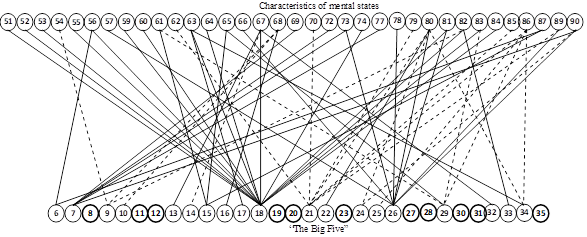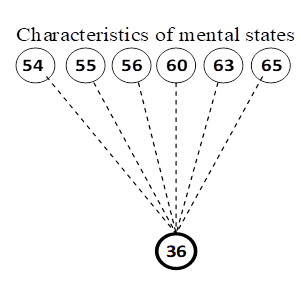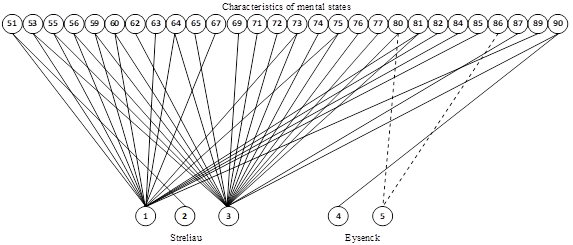Abstract
Deviant behavior does not always imply clear deviation from norms towards social disadaptation, criminal or addictive behavior. Deviance may be situational or have a latent nature. Deviations in behavior can be caused by a number of reasons: temperament and character, intrapersonal features and social conditions. In theoretical review of the article, various approaches are considered in studying the problems and causes of deviation. Psychological approach reveals the problems of personality associated with self-worth, with internal inhibitions and desires that lead to a conflict of personality with oneself. Within the phenomenological approach, an individual holistic psychic experience underlying deviation is being described. The study is aimed at exploring the linkages of personal characteristics of students with the states they experience. The aim of the study is to identify subject-personal correlates of states that can determine certain deviations in behavior. The methods used are: McCrae-Costa "Big Five" five-factor personality questionnaire, the methodology of self-assessment (Budassi), Eysenck EPI personality questionnaire, J. Streliau method for diagnosis of temperament, Prokhorov "Mental State Relief" questionnaire. Correlation relations of subject-personal characteristics with mental states were revealed. It was shown that the characteristics of the actual state depend on the strength of excitation, the degree of fatigue, the operability and switchability of the nervous processes, as well as on the ability to regulate the behavior volitionally. These correlations, which determine the specificity of experiences and behavioral responses depending on a person’s subject-personal qualities, can determine certain deviations in behavior if a certain quality has a negative orientation.
Keywords: Deviancemental statesexperiencesbehaviortemperament
Introduction
Deviant forms of behavior are often mediated by the features of person’s temperament and personality and depend on one’s emotional lability (instability) (Mendelevich, 2005).
The psychological approach in studying the causes of deviations reveals the linkage of deviant behavior with an intrapersonal conflict, when the deviant consciously or unconsciously seeks not to let himself realize the existing of these behaviors, destroying his own self-worth (Mendelevich, 2005). Phenomenological approach points to the individual holistic psychic experience underlying the deviant behavior (Mendelevich, 2005). In general, it is safe to say that the state of dissatisfaction with oneself, the destructive experiences of a person’s selfness – and, hence, the inability to control and regulate one's own states – determine deviant manifestations in behavior (Zmanovskaya, 2004).
Deviant behavior is not only situational reactions that deviate from a variety of norms, but also mental states that determine the experiences of a certain quality, leading to a person’s disadaptation in society or to a violation of self-actualization (Homich, 2006).
Mental states and their imbalances act as the basis and causes of deviant behavior, as well as the norms that determine the boundaries of deviations. Prokhorov determines psychic states as a person's reflection of the situation in the form of a stable holistic syndrome (combination) in the dynamics of mental activity, which is expressed in the unity of behavior and experience (Prokhorov, 2004; Prokhorov, 2011; Artishcheva, 2014).
The specificity of the course and regulation of mental states depends on many factors, including age and individual characteristics (Liu et al., 2010). That is, the person’s temperament or personality traits determine the likelihood of deviance in behavior, as well as the flow of mental states, which, in turn, can determine deviations. In this regard, we conducted a study aimed at identifying the relationship of mental states with subject-personal characteristics of a person.
Problem Statement
Specificity of mental states course depends on personal upbringing, culture, character and temperament. The same situations can cause different emotional and behavioral reaction in people. The subjects named and evaluated mental states which most often led to various deviations in behavior. Identification of subject-personal correlates of the studied states will allow to build a regulatory complex and carry out the prevention of deviations.
Research Questions
A person’s temperament or personality traits determine the likelihood of deviance in behavior, as well as the flow of mental states.
Purpose of the Study
Identification of subject-personal correlates of states that can determine certain deviations in behavior.
Research Methods
Students aged 18-22 were involved in the research (36 people). The following methods were used: Eysenck EPI personality questionnaire (Karelin, 2007), McCrae-Costa "The Big Five" five-factor personality questionnaire (Shmelyov, Pokhil’ko, 1993), the methodology of self-assessment (Budassi) (Nikireev, 2007), J. Streliau method for diagnosis of temperament (Mironova, 2005), Prokhorov "Mental State Relief" questionnaire. The following mental states were named and assessed by the subjects: fatigue, anger, irritation, anxiety, passivity, sadness, anxiety, apathy, resentment, imbalance.
Findings
The analysis of the results showed that mental states have interrelations with characteristics reflecting the properties of temperament and personality. Let us consider these interrelations in details.

Note: the indicators of
6 - activity - passivity, 7 - dominance - subordination, 8 - sociability – isolation. Search for impressions - avoidance of impressions, 9 - search for impressions - avoidance of impressions, 10- manifestation - avoiding the feeling of guilt, 11- warmth - indifference, 12 - cooperation - rivalry 13 - trustfulness - suspicion, 14 - understanding - misunderstanding, 15 - respect for others - self-respect, 16 - neatness - sloppiness (lack of neatness), 17- persistence - lack of persistence, 18 - responsibility - irresponsibility, 19 – behavioral self-control - impulsiveness (lack of behavioral self-control), 20 - foresight - carelessness, 21-anxiety - insouciance, 22-tension - relaxation, 23-depressiveness - emotional comfort, 24 - self-criticism - self-sufficiency, 25 - emotional lability – emotional stability , 26 - curiosity - conservatism, 27 - inquisitiveness - realism, 28 - artistry - lack of artistry, 29 - sensitivity - numbness, 30 - plasticity - rigidity, 31 – extraversion - introversion, 32 - affection – apartness, 33 - self-control - impulsivity, 34 - emotional stability - instability, 35 expressiveness - practicality.
Indicators of
Mental processes – 51 - sensation, sensitivity to external influences, 52 - clarity, awareness of perception, 53 - features of notions, 54 - memory, 55 - thinking, 56 - imagination, 57 - speech, 59 - volitional processes, 60 - attention.
Physiological reactions - 61- temperature sensations, 62 - state of muscle tone, 63 - coordination of movements, 64 - motor activity, 65 - cardiovascular system, 66 - manifestations from the gastrointestinal tract, 67 – sweating state, 68 - sensations from the side gastrointestinal tract, 69 - state of the oral mucosa, 70 - color of the skin.
Experiences – 72 - sadness-optimism, 73-affliction-joy, 74 - passivity-activity, 77 - lowers-raises, 78 - tension-emancipation, 79 - heaviness-lightness, 80 - stiffness-looseness.
Behavior – 81 - passivity-activity, 82 - inconsistency-consistency, 83 - impulsiveness-regularity, 84 - thoughtlessness-reasoning, 85 - uncontrollability-controllability, 86 - inadequacy-adequacy, 87 - relaxation-tension, 89 - uncertainty-confidence, 90- privateness-openness
The personal characteristics of sociability, cooperation, self-control of behavior, etc, are not related to the indicators of the states studied. That is, they do not determine these mental states and do not affect their course. In the structure of the relationship between personal characteristics and indicators of mental states, the personality structure-forming characteristics (7, 18, 21, 26) that have the greatest number of connections are revealed. Analyzing the identified links, we can claim that the desire for domination leads to optimism, fervor and mood rising, the behavior becomes open. A high level of responsibility determines the intensity of the course of mental processes (sensations, ideas, thinking, volitional processes, etc.), improves a number of physiological manifestations (coordination of movements, motor activity and vigor of movements), enhances the ability of experiencing. Also, with the growth of responsibility- there is more activity, consistency, dimensionality and thoughtfulness in behavior. Such personal qualities like curiosity, contribute to speech activity, experiences become fervent, relaxed, behavior becomes active, confident and open. High anxiety aggravates the somatic manifestations of the conditions (muscle tension, trembling of the hands, twitching, blushing of the face, arms and neck). Experiences with anxiety become more severe and constrained, behavior becomes uncontrollable, inadequate and uncertain.
Thus, we can predict that if a person is in a more dependent position, does not seek to dominate and take responsibility for himself, then passivity, closeness, uncertainty, imprudence, randomness might be seen in behavior. Volitional and thought processes weaken, somatic manifestations worsen, and there is muscle tension that might grow into trembling and twitching. Anxiety exacerbates negative physiological reactions and experiences, fetters behavior.
Next, we shall examine the structure of the relationship between mental states and self-esteem (Fig. 2).

Note: indicator according to
Indicators of
Mental processes - 53 - features of sensations, 54 - memory, 55 - thinking, 56 - imagination, 60 - attention.
Physiological reactions -63 - coordination of movements, 65 - cardiovascular system, 67 - sweating state, 69 - state of the oral mucosa.
Experiences - 74 - passivity-activity, 75 - sleepiness - cheerfulness, 76-lethargy-glibness.
Behavior - 89 - uncertainty-confidence.
The level of person’s self-evaluation forms negative correlations with the indices of the mental states studied. Extremely high self-esteem causes memory impairment, difficulties in remembering and reproducing, difficulties in thinking processes, deterioration of intelligence, the imagination becomes "clamped", the attention decreases, ability to concentrate on doing work decreases, clearness and coordination of movements become worse, and unpleasant feelings in the heart might be experienced. The revealed features show that self-assessment controls the course of mental processes and physiological reactions, no interdependence with emotional and behavioral manifestations were revealed. We can assume that the level of self-esteem does not determine the states, experiences and actions that can lead to deviations from accepted norms, by themselves, without mediating other causes.
Let us consider the role of the individual psychological background on the personality in the course of the psychic states studied (Fig. 3).

Note: indicators of
Indicators of
4 - extraversion-introversion; 5 - neuroticism.
Indicators of
Mental processes – 51 - sensation, sensitivity to external influences, 53-features of notions, 55-thinking, 56-imagination, 59-volitional processes, 60-attention.
Physiological responses 62 - state of muscle tone, 63-coordination of movements, 64-motor activity, 65-cardiovascular system, 67- sweating state, 69 - state of the oral mucosa.
Experiences - 71 - sadness-cheerfulness 72- sadness-optimism, 73-affliction-joy, 74-passivity-activity, 75-drowsiness-cheerfulness, 76- lethargy-glibness, 77- lowers-raises, 80-stiffness-looseness.
Behavior 81 - passivity-activity, 82 - inconsistency-consistency, 83 - impulsiveness-regularity, 84 - thoughtlessness-reasoning, 85 - uncontrollability-controllability, 86 - inadequacy-adequacy, 87 - relaxation-tension, 89 - uncertainty-confidence, 90- privateness-openness
In the structure of the relationship between mental states and individual psychological characteristics of a personality, the structure-forming indicators that reflect the strength of excitation and the mobility of the nervous processes were revealed. That is, the course of the mental states studied depends more on the human temperament: the strength of excitation, the degree of fatigue, the efficiency and switching-ability of the nervous processes. At the same time, the introverted qualities of a person, determining social adaptation, have virtually no impact on the course of these states, that is, they cannot mediate the propensity to deviation.
The reaction to stimulation determines the strength of sensations, the activity of thought processes and imagination, and influences volitional processes. Also, the reaction to excitement, the strength of excitation, determines the direction of experiences and behavior, and in particular, the level of activity, consistency, thoughtfulness, confidence and controllability of behavior. The degree of switching-ability of the human nervous processes, the ability to move from one activity to another is mediated by mental and volitional processes, and the brightness of images of sensations and imagination, affects the state of the cardiovascular system, muscle tone and motor activity. All of these trigger mental states of different modalities, of varying quality, actualizes a wide range of experiences (sadness-cheerfulness, lethargy-glibness, sadness-optimism, sleepiness-cheerfulness, sadness-fervor, passivity-activity, stiffness-looseness), and also determines behavioral reactions - their relaxation or tension, closeness or openness, passivity or activity
Conclusion
The flow of mental states (fatigue, anger, irritation, anxiety, passivity, sadness, anxiety, apathy, resentment, imbalance) depends on person’s personality and temperament. Propensity to dependency, anxiety and irresponsibility lead to passivity, closeness, uncertainty, imprudence, randomness. The volitional and thought processes weaken, somatic manifestations worsen, muscular tensions appear, negative experiences are aggravated. A weak reaction to excitation and suppressive inhibition determine the decrease in the intensity of mental processes, physiological manifestations, negatively toned experiences; dreariness, sadness, passivity appear; the behavior becomes close, passive, stressful.
These correlations, which determine the specificity of experiences and behavioral responses depending on a person’s subject-personal qualities, can determine certain deviations in behavior if certain quality has a negative orientation
Acknowledgments
The work is performed according to the Russian Government Program of Competitive Growth of Kazan Federal University.
References
- Artishcheva, L.V. (2014). Mental characteristics of psychic states images within the temporal continuum “past-present-future”. Middle-East Journal of Scientific Research, 20 (12), 1755-1760.
- Artishcheva, L.V. (2014). Temporal features of mental state image and person’s cognitive styles interrelation. (Candidate of science). Kazan federal university.
- Homich, A.V. (2006). Psychology of deviant behavior. Study guide. Rostov-on-Don: Southern Russian Humanitarian Institute.
- Karelin, A.A. (2007). Great encyclopedia of psychological tests. Moscow: Eksmo.
- Liu, Y., Prati, L.M., Perrewé, P.L., Brymer, R.A. (2010). Individual differences in emotion regulation, emotional experiences at work, and work-related outcomes: A two-study investigation. Journal of Applied Social Psychology, 40 (6), 1515-1538.
- Mendelevich, V.D. (2005). Psychology of deviant behavior. Study guide. St. Petersburg: Rech (Speech).
- Mironova, E.E. (2005). Collection of psychological tests. Minsk: ENVILA.
- Nikireev, E.M. Psychological peculiarities of the orientation of the individual: tutorial. Moscow: Moscow psychology-social Instituteю
- Prokhorov, A.O. (2004). Definition of the concept "mental state". Psychology of states. Anthology. Moscow: Rech (Speech).
- Prokhorov, A.O. (2011). Psychology of states: study guide. Moscow: "Kogito-centre".
- Shmelyov, A.G., Pokhil’ko, V.I. (1993). A taxonomy-oriented study of Russian personality-trait names.European Journal of Personality, 7, 1-17.
- Zmanovskaya, E.V. (2004). Deviantology (Psychology of deviant behavior). Moscow: Academy.
Copyright information

This work is licensed under a Creative Commons Attribution-NonCommercial-NoDerivatives 4.0 International License.
About this article
Publication Date
31 August 2017
Article Doi
eBook ISBN
978-1-80296-028-0
Publisher
Future Academy
Volume
29
Print ISBN (optional)
-
Edition Number
1st Edition
Pages
1-960
Subjects
Teacher, teacher training, teaching skills, teaching techniques
Cite this article as:
Artishcheva, L. V. (2017). Subject-Personality Correlates Of Mental States As Possible Determinants Of Deviant Behavior. In R. Valeeva (Ed.), Teacher Education - IFTE 2017, vol 29. European Proceedings of Social and Behavioural Sciences (pp. 67-73). Future Academy. https://doi.org/10.15405/epsbs.2017.08.02.9

